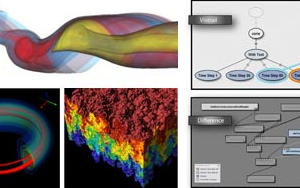 The SCI Institute is pleased to announce that it will be participating in three DOE SciDAC 2 research centers.
The SCI Institute is pleased to announce that it will be participating in three DOE SciDAC 2 research centers.The Visualization and Analytics Center for Enabling Technologies (VACET), includes SCI Institute faculty Chris Johnson (Center Co- PI with Wes Bethel from LBNL), Chuck Hansen, Steve Parker, Claudio Silva, Allen Sanderson and Xavier Tricoche. The center will focus on leveraging scientific visualization and analytics technology to increase scientific productivity and insight. It will be challenged with resolving one of the primary bottlenecks in contemporary science, making the massive amounts of data now available to scientists accessible and understandable. Advances in computational technology have resulted in an "information Big Bang," vastly increasing the amount of scientific data available, but also creating a significant challenge to reveal the structures, relationships, and anomalies hidden within the data. The VACET Center will respond to that challenge by adapting, extending, creating when necessary, and deploying visualization and data understanding technologies for the scientific community.
The center will involve collaborators at Lawrence Berkeley National Laboratory, Lawrence Livermore National Laboratory, Oak Ridge National Laboratory, and UC Davis.
For more information about VACET, please see the announcement "Seeing the Unsee-able" on the SciDAC website.
The The Scientific Data Management Center for Enabling Technologies, will include SCI Institute faculty Steve Parker and Claudio Silva in a project that builds upon previous success in the development of advanced data management technologies. This project will improve upon their scientific data management framework to address the needs of petascale science. Their goal is to develop a more comprehensive, acquisition to final analysis, data management solution that can handle the increasing scale and complexity of scientific data. They will enhance and extend existing tools to allow for more interactivity and workflow management, better feature extraction, and improved parallelism and scalability.
For this project, the SCI Institute will join collaborators working at Lawrence Berkeley National Laboratory, Argonne National Laboratory, Lawrence Livermore National Laboratory, Oak Ridge National Laboratory, Pacific Northwest National Laboratory, North Carolina State University, Northwestern University and the University of California at San Diego.
The Center for Technology for Advanced Scientific Component Software (TASCS), will include SCI Institute faculty Steve Parker to build upon previous success in the development of Common Component Architecture (CCA), a set of standards for component development that allows disparate components to be composed together to build a running application. This extensible component-based software architecture facilitates software interoperability between components developed by different teams across different institutions. TASCS will extend CCA methodology in collaboration with several key application projects, through an interlinked series of activities, to develop powerful new capabilities.
The TASCS Center involves the SCI Institute with collaborators from Argonne National Laboratory, Binghamton University, Indiana University, Lawrence Livermore National Laboratory, Los Alamos National Laboratory, Oak Ridge National Laboratory, Pacific Northwest National Laboratory, Sandia National Laboratories, Tech-X Corporation and the University of Maryland.
For more information about TASCS, please see the announcement "Plug and Play Supercomputing" on the SciDAC website.
